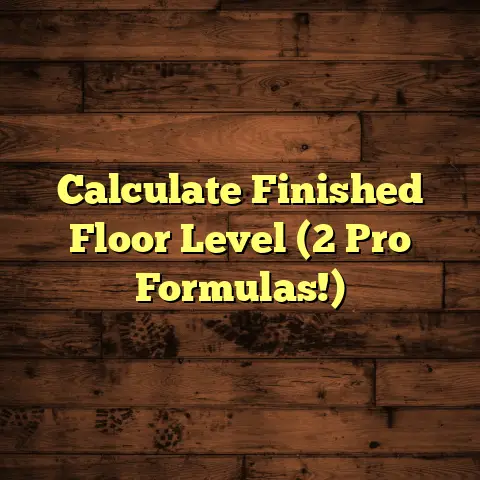Black Paper Under Wood? (1 Reason WHY!)
I’m talking about that mysterious black paper.
You know, the one that looks like it’s been there since the dawn of time?
I’m Mike, a flooring contractor with over 20 years of experience, and I’ve seen it all.
Let’s dive into why that black paper is there and what it means for your floors.
A Blast From The Past: Flooring’s Evolution
Flooring has come a long way, hasn’t it?
Back in the day, things were a lot simpler – and a lot less sophisticated.
Think about it: from dirt floors to stone slabs to eventually wood planks, the evolution has been fascinating.
Underlayments, the unsung heroes beneath our feet, have also evolved.
Early homes often lacked proper insulation and moisture control, making underlayments crucial.
Black paper, in its various forms, stepped in to fill that need.
But what exactly is this stuff?
Decoding Black Paper: What’s It Made Of?
When I say “black paper,” I’m usually referring to asphalt-impregnated paper or tar paper.
It’s essentially heavy paper saturated with asphalt or tar, creating a water-resistant barrier.
Think of it as the old-school version of today’s moisture barriers.
The asphalt or tar gives it that distinctive black color and a slightly oily feel.
This composition was chosen for its water-resistant properties and its relative affordability back in the day.
But why was it so important to have this barrier in the first place?
The Main Event: Moisture, The Enemy of Wood
Here’s the deal: the primary reason for black paper under wood flooring is to act as a moisture barrier.
Yep, that’s it. Simple, right?
But the implications are huge.
Wood is a natural material, and it’s incredibly susceptible to moisture.
Think of what happens when you leave a wooden cutting board in the sink overnight.
Not pretty, is it?
The same thing can happen to your wood floors if moisture creeps up from the subfloor.
This moisture can come from the ground, especially in basements or homes without proper foundations.
It can also come from humidity in the air.
The black paper acts as a shield, preventing this moisture from reaching the wood and causing all sorts of problems.
Think about it: without this barrier, you’re looking at potential issues like:
- Warping: Wood expands and contracts with moisture changes, leading to uneven surfaces.
- Cupping: The edges of the wood planks rise, creating a concave surface.
- Buckling: The wood lifts off the subfloor, creating unsightly and potentially dangerous bumps.
- Mold and Mildew: Damp environments are breeding grounds for these unwelcome guests, leading to health concerns.
- Decay: Over time, excessive moisture can cause the wood to rot, compromising the structural integrity of your floor.
So, that seemingly insignificant layer of black paper is actually a crucial line of defense against these costly and frustrating issues.
But how much of a difference does it really make?
The Long Game: Flooring Longevity
Let’s talk about the lifespan of your floors.
A properly installed wood floor can last for decades, even generations.
But without adequate moisture protection, that lifespan can be drastically reduced.
I’ve seen floors that were installed without a moisture barrier fail within just a few years, while those with a barrier have stood the test of time.
While it’s hard to give you an exact percentage increase in lifespan (it depends on so many factors like climate, subfloor moisture levels, and the type of wood), I can tell you this: a moisture barrier is a must-have for any wood flooring installation.
Think of it as an investment in the longevity of your home.
According to the National Wood Flooring Association (NWFA), proper moisture management is one of the most critical factors in ensuring the long-term performance of wood flooring.
They recommend maintaining consistent humidity levels and using appropriate moisture barriers to prevent issues.
But it’s not just about function, right?
What about the look and feel of your floors?
The Aesthetics Angle: More Than Just Protection
Believe it or not, black paper can also contribute to the overall aesthetic of your flooring.
It provides a relatively smooth and even surface for the wood to be installed on.
This is especially important if your subfloor has minor imperfections or irregularities.
The black paper can help to mask these imperfections, creating a more uniform and visually appealing finished product.
It can also help to prevent the wood from squeaking, as it provides a cushioning layer between the wood and the subfloor.
I’ve seen cases where homeowners were amazed at how much smoother and quieter their floors were after installing black paper.
But let’s get real for a moment.
While black paper has its benefits, it’s not a perfect solution.
Real-World Stories: Case Studies From The Field
I’ve encountered countless situations where black paper played a significant role in the outcome of a flooring project.
Here are a couple that stand out:
Case Study 1: The Basement Renovation
A homeowner in Minneapolis was renovating their basement and wanted to install hardwood flooring.
Upon removing the old carpet, they discovered black paper underneath.
They were initially unsure whether to remove it or leave it in place.
After consulting with me, they decided to keep the black paper and add an additional layer of modern moisture barrier for extra protection.
The result? Beautiful, long-lasting hardwood floors in their basement, free from moisture-related issues.
Case Study 2: The Historic Home
In an older home in St. Paul, I was called in to assess water-damaged wood floors.
The homeowner had noticed cupping and warping in several areas.
Upon inspection, it was clear that the original black paper underlayment had deteriorated over time, allowing moisture to penetrate.
The solution involved removing the damaged flooring, replacing the black paper with a modern moisture barrier, and installing new hardwood.
These stories highlight the importance of understanding the role of black paper and the need to address moisture issues proactively.
But what about today? Is black paper still the go-to choice for underlayment?
The Modern Landscape: Current Flooring Trends
While black paper was once a staple in flooring installations, modern materials have largely taken its place.
Today, we have a wide range of advanced moisture barriers and underlayments that offer superior performance and durability.
These include:
- Polyethylene Films: These plastic films are highly effective at blocking moisture and are widely used in residential and commercial applications.
- Engineered Underlayments: These composite materials offer a combination of moisture protection, sound insulation, and cushioning.
- Self-Adhesive Membranes: These membranes provide a seamless and waterproof barrier, ideal for demanding environments.
While black paper may still be found in some older homes, it’s generally not recommended for new installations.
Modern materials offer better protection, longer lifespan, and often, easier installation.
But what about the environmental impact of these materials?
Green Choices: Environmental Considerations
As consumers become more environmentally conscious, sustainable flooring practices are gaining traction.
Traditional black paper, with its asphalt or tar content, isn’t exactly the most eco-friendly material.
Fortunately, there are now many sustainable alternatives available, including:
- Recycled Content Underlayments: These products are made from recycled materials, reducing waste and conserving resources.
- Natural Fiber Underlayments: Materials like cork and wool offer excellent moisture resistance and insulation, while being biodegradable and renewable.
- Low-VOC Adhesives: These adhesives minimize the emission of harmful volatile organic compounds, improving indoor air quality.
Choosing sustainable flooring materials is not only good for the environment but can also enhance the health and well-being of your family.
Wrapping Up: Knowledge is Power
So, there you have it: the mystery of the black paper under wood flooring, solved!
It’s all about moisture protection.
Understanding the reasons behind its presence can empower you to make informed decisions about your flooring projects.
Whether you’re renovating an old home or building a new one, knowing the importance of moisture barriers is crucial for ensuring the longevity and beauty of your wood floors.
Don’t underestimate the power of that seemingly insignificant layer beneath your feet!
It can make all the difference between a floor that lasts for generations and one that succumbs to the ravages of moisture.
Your Turn: Share Your Story!
Now, I’d love to hear from you!
Have you ever encountered black paper under your wood floors?
What was your experience?
Did you find it beneficial, or did you encounter any issues?
Share your stories and insights in the comments below!
Let’s learn from each other and create beautiful, long-lasting floors together.
And if you have any questions about flooring, don’t hesitate to ask!
I’m always happy to share my expertise and help you make the best choices for your home.
Happy flooring!





